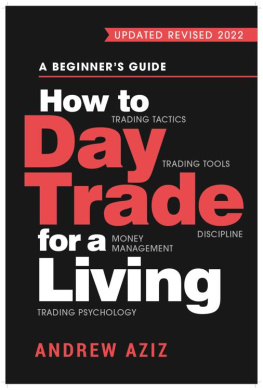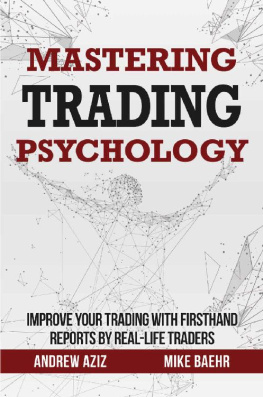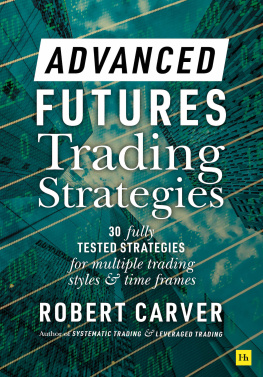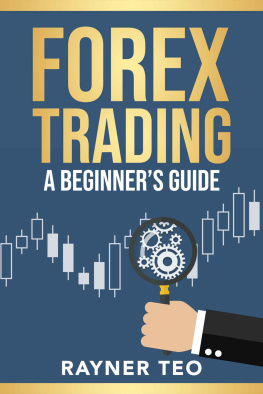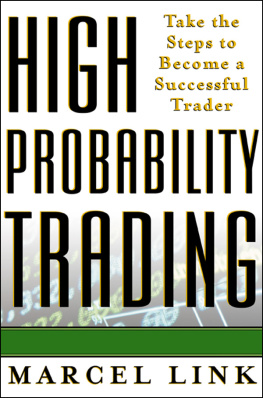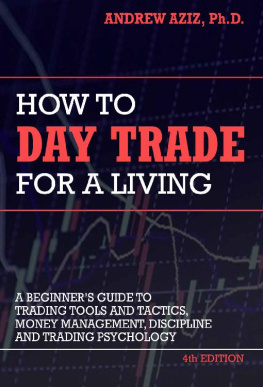Andrew Aziz - Advanced Techniques in Day Trading: A Practical Guide to High Probability Day Trading Strategies and Methods
Here you can read online Andrew Aziz - Advanced Techniques in Day Trading: A Practical Guide to High Probability Day Trading Strategies and Methods full text of the book (entire story) in english for free. Download pdf and epub, get meaning, cover and reviews about this ebook. year: 2018, genre: Business. Description of the work, (preface) as well as reviews are available. Best literature library LitArk.com created for fans of good reading and offers a wide selection of genres:
Romance novel
Science fiction
Adventure
Detective
Science
History
Home and family
Prose
Art
Politics
Computer
Non-fiction
Religion
Business
Children
Humor
Choose a favorite category and find really read worthwhile books. Enjoy immersion in the world of imagination, feel the emotions of the characters or learn something new for yourself, make an fascinating discovery.
- Book:Advanced Techniques in Day Trading: A Practical Guide to High Probability Day Trading Strategies and Methods
- Author:
- Genre:
- Year:2018
- Rating:5 / 5
- Favourites:Add to favourites
- Your mark:
- 100
- 1
- 2
- 3
- 4
- 5
Advanced Techniques in Day Trading: A Practical Guide to High Probability Day Trading Strategies and Methods: summary, description and annotation
We offer to read an annotation, description, summary or preface (depends on what the author of the book "Advanced Techniques in Day Trading: A Practical Guide to High Probability Day Trading Strategies and Methods" wrote himself). If you haven't found the necessary information about the book — write in the comments, we will try to find it.
Advanced Techniques in Day Trading: A Practical Guide to High Probability Day Trading Strategies and Methods — read online for free the complete book (whole text) full work
Below is the text of the book, divided by pages. System saving the place of the last page read, allows you to conveniently read the book "Advanced Techniques in Day Trading: A Practical Guide to High Probability Day Trading Strategies and Methods" online for free, without having to search again every time where you left off. Put a bookmark, and you can go to the page where you finished reading at any time.
Font size:
Interval:
Bookmark:
A Practical Guide to High
Probability Strategies and Methods
Andrew Aziz, Ph.D.
Day Trader at Bear Bull Traders
The author and www.BearBullTraders.com (the Company), including its employees, contractors, shareholders and affiliates, are NOT an investment advisory service, a registered investment advisor or a broker-dealer and do not undertake to advise clients on which securities they should buy or sell for themselves. It must be understood that a very high degree of risk is involved in trading securities. The Company, the authors, the publisher and the affiliates of the Company assume no responsibility or liability for trading and investment results. Statements on the Company's website and in its publications are made as of the date stated and are subject to change without notice. It should not be assumed that the methods, techniques or indicators presented in these products will be profitable nor that they will not result in losses. In addition, the indicators, strategies, rules and all other features of the Company's products (collectively, the Information) are provided for informational and educational purposes only and should not be construed as investment advice. Examples presented are for educational purposes only. Accordingly, readers should not rely solely on the Information in making any trades or investments. Rather, they should use the Information only as a starting point for doing additional independent research in order to allow them to form their own opinions regarding trading and investments. Investors and traders must always consult with their licensed financial advisors and tax advisors to determine the suitability of any investment.
Introduction
This publication can be regarded as a sequel to my first book, How to Day Trade for a Living: A Beginners Guide to Tools and Tactics, Money Management, Discipline and Trading Psychology .
In that first book, I explained the fundamentals of day trading and how day trading is different from other styles of trading and investing. In the process, I also described important trading strategies that many traders use each day. Although I sense my first book well-served many new traders, I know it left many more experienced traders looking for a more detailed guide. There was a sacrifice I had to make in writing the first book. That book was intended to be for beginners, and I had to make a choice between a detailed and very likely overwhelming guide, or a simpler guide that was aimed for the novice trader.
After much thought, I decided to review the entire day trading process, but not in significant detail. For example, I wrote about strategies and scanners, but I did not dive into the technical parameters of scanners that often leave new traders terrified and lost. I wanted to establish important and vital fundamentals and overview the most important strategies which need to be mastered. This, my second book, utilizes those fundamentals and strategies as a launching pad to explain some of the more advanced strategies and methods involved in day trading.
If you have read the first book ( How to Day Trade for a Living), then Advanced Techniques in Day Trading will serve as a reminder, or a kind of refresher course on the basics, with a deeper dive into the technical. If you have not yet read How to Day Trade for a Living , I think you will find this publications somewhat condensed version of that basic information easy to understand as it then introduces you to more advanced techniques. To maximize your learning experiences, however, I recommend reading (and then regularly re-reading and consulting) both books. I believe you will find them to be useful guides and references at all stages of your career as a trader. And dont just strictly study my books. There are many excellent resources out there. A successful day trader is definitely a lifelong learner.
Intermediate traders may benefit from the first books overview of some of the classic strategies that the majority of retail traders use effectively. If you dont consider yourself a novice trader, then you may wish to jump ahead and start reading (or re-reading) at Chapter 7 for an overview of the most important day trading strategies. However, I encourage you to skim through the earlier chapters as well. Becoming a consistently profitable trader will not require you to master complicated new trading strategies every day. The strategies in Chapter 7 of How to Day Trade for a Living are the ones that traders have used for over a decade. They have worked thus far and really do need to be mastered. Work on simple and well-known strategies, but adjust them over time to complement your own personality and whatever the current market conditions are. Success in trading is not a revolution; it is an evolution.
Whether you are a novice trader or one with some experience, these books can equip you with an understanding of where to start, how to start, what to expect from day trading, and how you can develop your own strategy. Simply reading books will, of course, not make you a profitable trader. Profits in trading do not come from reading one or two, or even a dozen books, but, as I explain, profits can come with practice, the right tools and software, and proper ongoing education.
While I tried to avoid repetition, I must confess to traders who read my first book, some parts may seem redundant or repetitive. Again, a hard choice and a sacrifice had to be made. I want this book to be the addition to the first book, but still this book needs to stand alone and be coherent for anyone who is new to day trading or has not read the first book yet. Therefore, I apologize in advance if you find some parts repetitive. You may want to skim through those sections faster.
There are two styles of trading: discretionary and mechanical systems based .
Discretionary traders evaluate potential trades based on their trading plan, using technical analysis to determine if each trade meets their requirements. Although the discretionary traders rules are known, the trader decides to take or pass on trades based on their experience. The discretionary trader doesnt follow a firm algorithm of entries and exits. Instead, they weigh all available information, and then make a call.
Mechanical systems, on the other hand, are trading strategies that a computer program can execute. The mechanical system is often based on technical inputs such as price and indicators. The strategies are usually programmed into a computer software program that can backtest them on historical market data to determine if they produce positive expectancy: namely, if they produce higher profits than losses over the long term and in comparison to the overall market. Rarely does a trader need to make a decision when using mechanical systems. Institutional trading, high frequency trading and algorithms are all examples of mechanical systems based trading. There are many firms, educators, traders and even online scammers who develop these types of computer programs and systems and sell them to traders.
The two approaches both have advantages and disadvantages: discretionary trading offers a fresh look at each trading opportunity and lets the trader pass on trades when information that may not be easily captured in a computer program indicates a decreased chance of success. However, because the discretionary trader must make a decision for each trade, traders are more prone to emotional trading and acts of self-deception, such as falling in love with a trade, that will often result in a failure to follow their trading plan.
Mechanical trading, on the other hand, largely takes the traders decision-making process out of the equation. A computer algorithm executes the trades as programmed. The only input on the traders part is the amount of capital devoted to each trade. The trader just determines the share size, and after that the trader can step back and watch the computer work its magic. But mechanical trading systems also have their drawbacks. Can a system be designed to capture all contingencies or possibilities that may arise? I dont believe so. And when losses occur, the mechanical trader must determine whether the loss is a temporary part of the system or whether it represents a fundamental failure of the strategy.
Font size:
Interval:
Bookmark:
Similar books «Advanced Techniques in Day Trading: A Practical Guide to High Probability Day Trading Strategies and Methods»
Look at similar books to Advanced Techniques in Day Trading: A Practical Guide to High Probability Day Trading Strategies and Methods. We have selected literature similar in name and meaning in the hope of providing readers with more options to find new, interesting, not yet read works.
Discussion, reviews of the book Advanced Techniques in Day Trading: A Practical Guide to High Probability Day Trading Strategies and Methods and just readers' own opinions. Leave your comments, write what you think about the work, its meaning or the main characters. Specify what exactly you liked and what you didn't like, and why you think so.


